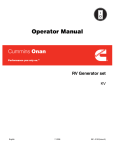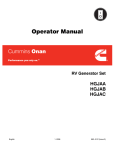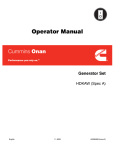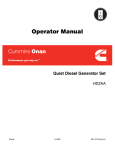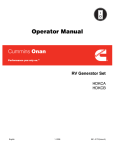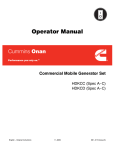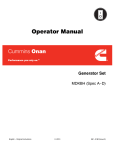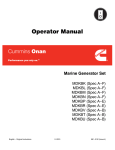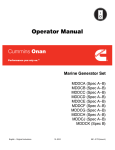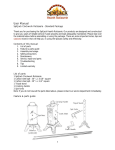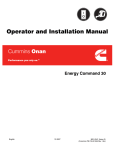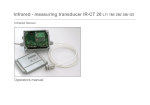Download Operator Manual
Transcript
Operator Manual Commercial Mobile Generator Set HDKAL HDKAS English 7-2009 981−0104 (Issue 3) California Proposition 65 Warning Diesel engine exhaust and some of its constituents are known to the State of California to cause cancer, birth defects, and other reproductive harm. Table of Contents SAFETY PRECAUTIONS . . . . . . . . . . . . . . . . . . . . . . . . . . . . . . . . . . . . . . . . . . . . . . . . . . . . . 2 INTRODUCTION . . . . . . . . . . . . . . . . . . . . . . . . . . . . . . . . . . . . . . . . . . . . . . . . . . . . . . . . . . . . 4 About this Manual . . . . . . . . . . . . . . . . . . . . . . . . . . . . . . . . . . . . . . . . . . . . . . . . . . . . . 4 Model Identification . . . . . . . . . . . . . . . . . . . . . . . . . . . . . . . . . . . . . . . . . . . . . . . . . . . . 4 Fuel Recommendations . . . . . . . . . . . . . . . . . . . . . . . . . . . . . . . . . . . . . . . . . . . . . . . . 4 Engine Oil Recommendations . . . . . . . . . . . . . . . . . . . . . . . . . . . . . . . . . . . . . . . . . . . 5 Batteries . . . . . . . . . . . . . . . . . . . . . . . . . . . . . . . . . . . . . . . . . . . . . . . . . . . . . . . . . . . . . 5 Genset-Mounted Control Panel . . . . . . . . . . . . . . . . . . . . . . . . . . . . . . . . . . . . . . . . . 5 Remote Control Panels . . . . . . . . . . . . . . . . . . . . . . . . . . . . . . . . . . . . . . . . . . . . . . . . 5 OPERATION . . . . . . . . . . . . . . . . . . . . . . . . . . . . . . . . . . . . . . . . . . . . . . . . . . . . . . . . . . . . . . . . 6 Pre-Start Checks . . . . . . . . . . . . . . . . . . . . . . . . . . . . . . . . . . . . . . . . . . . . . . . . . . . . . . 6 Starting . . . . . . . . . . . . . . . . . . . . . . . . . . . . . . . . . . . . . . . . . . . . . . . . . . . . . . . . . . . . . . 6 Stopping . . . . . . . . . . . . . . . . . . . . . . . . . . . . . . . . . . . . . . . . . . . . . . . . . . . . . . . . . . . . . 7 Powering Appliances . . . . . . . . . . . . . . . . . . . . . . . . . . . . . . . . . . . . . . . . . . . . . . . . . . 7 Connections to Utility Power . . . . . . . . . . . . . . . . . . . . . . . . . . . . . . . . . . . . . . . . . . . . 8 Resetting Line Circuit Breakers . . . . . . . . . . . . . . . . . . . . . . . . . . . . . . . . . . . . . . . . . 8 Engine Break-In . . . . . . . . . . . . . . . . . . . . . . . . . . . . . . . . . . . . . . . . . . . . . . . . . . . . . . . 8 No-load Operation . . . . . . . . . . . . . . . . . . . . . . . . . . . . . . . . . . . . . . . . . . . . . . . . . . . . . 8 Genset Exercise . . . . . . . . . . . . . . . . . . . . . . . . . . . . . . . . . . . . . . . . . . . . . . . . . . . . . . 9 Genset Storage . . . . . . . . . . . . . . . . . . . . . . . . . . . . . . . . . . . . . . . . . . . . . . . . . . . . . . . 9 Returning Genset to Service . . . . . . . . . . . . . . . . . . . . . . . . . . . . . . . . . . . . . . . . . . . . 9 PERIODIC MAINTENANCE SCHEDULE . . . . . . . . . . . . . . . . . . . . . . . . . . . . . . . . . . . . . . 10 MAINTENANCE PROCEDURES . . . . . . . . . . . . . . . . . . . . . . . . . . . . . . . . . . . . . . . . . . . . . 11 General Inspection . . . . . . . . . . . . . . . . . . . . . . . . . . . . . . . . . . . . . . . . . . . . . . . . . . . 11 Changing Oil and Oil Filter . . . . . . . . . . . . . . . . . . . . . . . . . . . . . . . . . . . . . . . . . . . . . 12 Air Cleaner Maintenance . . . . . . . . . . . . . . . . . . . . . . . . . . . . . . . . . . . . . . . . . . . . . . 13 Spark Arrestor Cleaning . . . . . . . . . . . . . . . . . . . . . . . . . . . . . . . . . . . . . . . . . . . . . . . 13 Batteries . . . . . . . . . . . . . . . . . . . . . . . . . . . . . . . . . . . . . . . . . . . . . . . . . . . . . . . . . . . . 13 Engine Cooling System . . . . . . . . . . . . . . . . . . . . . . . . . . . . . . . . . . . . . . . . . . . . . . . 14 Fuel System . . . . . . . . . . . . . . . . . . . . . . . . . . . . . . . . . . . . . . . . . . . . . . . . . . . . . . . . . 16 TROUBLESHOOTING . . . . . . . . . . . . . . . . . . . . . . . . . . . . . . . . . . . . . . . . . . . . . . . . . . . . . . 18 Engine Does Not Crank . . . . . . . . . . . . . . . . . . . . . . . . . . . . . . . . . . . . . . . . . . . . . . . 18 Engine Cranks But Does Not Start . . . . . . . . . . . . . . . . . . . . . . . . . . . . . . . . . . . . . 19 Fault Shutdown . . . . . . . . . . . . . . . . . . . . . . . . . . . . . . . . . . . . . . . . . . . . . . . . . . . . . . 19 Engine Lacks Power or Unstable . . . . . . . . . . . . . . . . . . . . . . . . . . . . . . . . . . . . . . 20 No Output Voltage . . . . . . . . . . . . . . . . . . . . . . . . . . . . . . . . . . . . . . . . . . . . . . . . . . . . 20 SPECIFICATIONS . . . . . . . . . . . . . . . . . . . . . . . . . . . . . . . . . . . . . . . . . . . . . . . . . . . . . . . . . . 22 INFORMATION FOR CALIFORNIA GENSET USERS . . . . . . . . . . . . . . . . . . . . . . . . . . . 23 HOW TO OBTAIN SERVICE . . . . . . . . . . . . . . . . . . . . . . . . . . . . . . . . . . . . . . . . . . . . . . . . . 24 MAINTENANCE RECORD . . . . . . . . . . . . . . . . . . . . . . . . . . . . . . . . . . . . . . . . . . . . . . . . . . . 25 1 Safety Precautions Thoroughly read the OPERATOR’S MANUAL before operating the genset. Safe operation and top performance can be obtained only by proper operation and maintenance. cally live parts can cause severe personal injury or death. The following symbols in this Manual alert you to potential hazards to the operator, service personnel and equipment. • Used engine oil has been identified by some state and federal agencies as causing cancer or reproductive toxicity. Do not ingest, inhale, or contact used oil or its vapors. alerts you to an immediate hazard which will result in severe personal injury or death. • Do not work on the genset when mentally or physically fatigued or after consuming alcohol or drugs. alerts you to a hazard or unsafe practice which can result in severe personal injury or death. • Carefully follow all applicable local, state and federal codes. CAUTION alerts you to a hazard or unsafe practice which can result in personal injury or equipment damage. • Generator output connections must be made by a qualified electrician in accordance with applicable codes. Electricity, fuel, exhaust, moving parts and batteries present hazards which can result in severe personal injury or death. • The genset must not be connected to the public utility or any other source of electrical power. Connection could lead to electrocution of utility workers, damage to equipment and fire. An approved switching device must be used to prevent interconnections. WARNING GENERATOR VOLTAGE IS DEADLY! GENERAL PRECAUTIONS • Keep ABC fire extinguishers handy. • Make sure all fasteners are secure and torqued properly. • Use caution when working on live electrical equipment. Remove jewelry, make sure clothing and shoes are dry and stand on a dry wooden platform on the ground or floor. • Keep the genset and its compartment clean. Excess oil and oily rags can catch fire. Dirt and gear stowed in the compartment can restrict cooling air. FUEL IS FLAMMABLE AND EXPLOSIVE • Keep flames, cigarettes, sparks, pilot lights, electrical arc-producing equipment and switches and all other sources of ignition well away from areas where fuel fumes are present and areas sharing ventilation. • Let the engine cool down before removing the coolant pressure cap or opening the coolant drain. Hot coolant under pressure can spray out and cause severe burns. • Before working on the genset, disconnect the negative (−) battery cable at the battery to prevent starting. • Fuel lines must be secured, free of leaks and separated or shielded from electrical wiring. • Use approved non-conductive flexible fuel hose for fuel connections at the genset. • Use caution when making adjustments while the genset is running—hot, moving or electri- 2 ENGINE EXHAUST IS DEADLY! BATTERY GAS IS EXPLOSIVE • Learn the symptoms of carbon monoxide poisoning in this manual. • Wear safety glasses and do not smoke while servicing batteries. • Never sleep in the vehicle while the genset is running unless the vehicle has a working carbon monoxide detector. • When disconnecting or reconnecting battery cables, always disconnect the negative (−) battery cable first and reconnect it last to reduce arcing. • The exhaust system must be installed in accordance with the genset Installation Manual. DO NOT OPERATE IN FLAMMABLE AND EXPLOSIVE ENVIRONMENTS • Do not use engine cooling air to heat the vehicle interior. Flammable vapor can cause a diesel engine to overspeed and become difficult to stop, resulting in possible fire, explosion, severe personal injury and death. Do not operate a diesel-powered genset where a flammable vapor environment can be created by fuel spill, leak, etc., unless the genset is equipped with an automatic safety device to block the air intake and stop the engine. The owners and operators of the genset are solely responsible for operating the genset safely. Contact your authorized Cummins Onan dealer or distributor for more information. • Make sure there is ample fresh air when operating the genset in a confined area. MOVING PARTS CAN CAUSE SEVERE PERSONAL INJURY OR DEATH • Do not wear loose clothing or jewelry near moving parts such as PTO shafts, fans, belts and pulleys. • Keep hands away from moving parts. • Keep guards in place over fans, belts, pulleys, etc. mobile-5 3 Introduction ABOUT THIS MANUAL This manual covers operation and maintenance of the model HDKAL and HDKAS generator sets (gensets). Study this manual carefully and observe all of its instructions and precautions. Using the genset properly and maintaining it regularly will promote longer genset life, better performance, and safer operation. Each operator should become thoroughly familiar with this manual. Keep this manual in a convenient location for quick reference. MODEL IDENTIFICATION When you call for service or parts have the genset model number and serial number ready (Figure 1). For ready reference, record these numbers in the boxes shown. FUEL RECOMMENDATIONS WARNING Diesel fuel is combustible and can cause severe personal injury or death. Do not smoke near fuel tanks or fuel-burning equipment or in areas sharing ventilation with such equipment. Keep flames, sparks, pilot flames, electrical arcs and switches and all other sources of ignition well away. Keep a type ABC fire extinguisher handy. RECORD MODEL AND SERIAL NUMBERS HERE MODEL NUMBER Use clean, fresh No. 2 diesel fuel (ASTM 2-D) when the outdoor ambient temperature is above freezing, and No. 1 diesel fuel (ASTM 1-D) when below freezing. The fuel should have a Cetane number of at least 45 for reliable starting. SERIAL NUMBER FIGURE 1. TYPICAL NAMEPLATE Note: Only low sulfer diesel or Ultra Low Sulfur Diesel (ULSD) fuel that meets the ASTM D975 or EN 590 standard for lubricity may be used with this engine. The 1 to 2 percent less energy content of the fuel can have a slight effect on maximum engine power. Note: B5 Bio-Diesel fuel that meets industry specifications and quality is suitable for use with this engine. 4 ENGINE OIL RECOMMENDATIONS Hour Meter: Indicates the number of hours the genset has run. It cannot be reset. Use premium quality motor oil. Look for the API (American Petroleum Institute) classification and use Class CF-4 or CF or better oil. Also look for the SAE (Society of Automotive Engineers) viscosity grade. Referring to Figure 2, choose the viscosity grade appropriate for the range of ambient temperatures expected before the next scheduled oil change. Multi-grade oils such as SAE 15W-40 are recommended for year-round use. Fault Reset Breaker: Trips and shuts down the genset when there is a low oil pressure or high coolant temperature fault condition. Reset by pushing in the red button. REMOTE CONTROL PANELS Remote control panels with a control switch and engine gauges are available. S S t t o a p r t FIGURE 2. SAE VISCOSITY GRADE vs. AMBIENT TEMPERATURE BATTERIES DC The genset requires a 12 volt battery to power its control and starting circuits. Reliable genset starting and starter service life depend upon adequate battery system capacity and maintenance. See Specifications for battery requirements and Periodic Maintenance for battery care. Control Brkr GENSET-MOUNTED CONTROL PANEL Figure 3 illustrates the genset control panel. Start-Stop-Preheat Switch (S1): Starts the genset when held at Start and stops the genset when momentarily touched to Stop. Holding the switch at Stop causes the glow plugs to preheat the combustions chambers. DC Control Breaker: Protects the control circuits from shorts to ground. Can be used as an emergency stop switch. Reset with handle. Fault Brkr FIGURE 3. GENSET CONTROL PANEL 5 Operation EXHAUST GAS IS DEADLY! Engine exhaust contains carbon monoxide, a poisonous, odorless and colorless gas that can cause unconsciousness and death. Symptoms of carbon monoxide poisoning include: • Dizziness • Throbbing in Temples • Nausea • Muscular Twitching • Headache • Vomiting • Weakness • Trouble Thinking Clearly • Sleepiness GET EVERYONE OUT INTO FRESH AIR IMMEDIATELY IF ANYONE EXPERIENCES ANY OF THESE SYMPTOMS. Seek medical attention if symptoms persist. Never sleep in the vehicle when the genset is running unless the vehicle has an operating carbon monoxide detector. Look and listen for leaks along the entire run of the exhaust system every time you start up the genset and every eight hours if the genset is being run continuously. Shut down the genset immediately if there is a leak and do not run it until the leak has been repaired. The installation of the exhaust system must be in accordance with the genset Installation Manual. PRE-START CHECKS Do not crank for more than 15 seconds at a time. Wait two minutes before trying again. See Troubleshooting if the engine does not start on the second try. Perform General Inspection (p. 11). Check for fuel, exhaust, oil and coolant leaks every eight hours if the genset is being run continuously. CAUTION Excessive cranking can overheat and damage the starter. Do not crank for more than 15 seconds at a time and wait two minutes before trying again. Check the Maintenance Record and perform any maintenance due (Periodic Maintenance Schedule). Also see GENSET BREAK-IN if the genset is new and RETURNING THE GENSET TO SERVICE if the vehicle has been in storage. 4. Connect the electrical loads after the genset has warmed up for a few minutes. STARTING 5. Check for fuel, exhaust, oil and coolant leaks and complete General Inspection (p. 11). Check the engine gauges regularly (if provided) while the genset is running. 1. Disconnect all loads from the genset. 2. Preheat − Hold the control switch in the PREHEAT position for the following number of seconds depending on ambient temperature: • Oil Pressure Gauge: Normal engine oil pressure is 28 − 64 psi (194 − 442 kPa) at normal operating temperature. 10 seconds—above 50° F (10° C) 15 seconds—0° F to 50° F (−17° to 10° C) 20 seconds—below 0° F (−17° C) • DC Voltmeter: Normal DC system voltage is 12.5 − 15 volts depending on battery condition and state-of-charge. CAUTION Preheat times longer than 20 seconds can damage the glow plugs. • Coolant Temperature Gauge: Normal engine coolant temperature is 160 −195° F (71 − 91° C) depending on load and ambient temperature. 3. Start − Immediately after PREHEAT push the control switch to START and hold it there until the engine starts. The starter will automatically disconnect as the engine starts up. 6 STOPPING TABLE 1. TYPICAL APPLIANCE LOADS Appliance Before stopping let the genset cool down by running at no-load for three to five minutes. Then touch the control switch momentarily to STOP. Load (watt) Air Conditioner 1400-2000 Battery Charger Up to 800 DC Converter 300-1500 Refrigerator 600-1000 Microwave Oven 1000-1500 Electric Frying Pan/Wok 1000-1500 Electric Stove Element 350-1000 The genset can power AC motors, air conditioners, AC/DC converters and other appliances. How much appliance load* can be serviced depends upon the genset power rating. The genset will shut down or its circuit breakers will trip if the sum of the loads exceeds genset rating. Electric Water Heater 1000-1500 Electric Iron 500-1200 Electric Hair Dryer 800-1500 Coffee Percolator 550-750 Television 200-600 To avoid overloading the genset and causing shutdowns, compare the sum of the loads of the appliances that are likely to be used at the same time to the power rating of the genset. Use Table 1 or the ratings on the appliances themselves (if so marked) to obtain the individual appliance loads. It may be necessary to run fewer appliances at the same time so that the sum of the loads is not greater than genset rating. Radio 50-200 Electric Drill 250-750 Electric Broom 200-500 Electric Blanket 50-200 CAUTION Failure to let the engine cool down before stopping can lead to engine damage. Let the genset run three to five minutes at no-load before stopping. POWERING APPLIANCES TABLE 2. MAXIMUM POWER VS. ALTITUDE Note that the genset may shut down due to overload, even though the sum of the loads is less than genset rating, when a large motor or air conditioner is started last or cycles off and then on again. The reason for this is that motor startup load is much larger than running load. It may be necessary to run fewer appliances when large motors and air conditioners are cycling on and off. Elevation above Sea Level at/below 500 ft (152 m) 7500 W (rated) at 2500 ft (762 m) 7050 W at 5500 ft (1676 m) 6375 W above 5500 ft (1676 m) Note that air density decreases as altitude increases, decreasing engine power. Power decreases approximately 3 percent of rated power every 1000 feet (305 m) that elevation increases above sea level. See Table 2 for typical calculations. It may be necessary to operate fewer appliances at higher altitudes. Maximum Power 6375 W minus 225 W every 1000 ft (305 m) * Appliance load and genset power are measured in terms of watt (W) or kilowatt (kW), where 1 kilowatt (kW) = 1000 watt (W). 7 CONNECTIONS TO UTILITY POWER A vehicle that has provisions for connection to utility power must be equipped with an approved transfer switch to keep the genset and utility power from being interconnected. WARNING Backfeed to utility power can cause electrocution and damage to equipment. Use an approved device to prevent the genset from being interconnected with utility power. RESETTING LINE CIRCUIT BREAKERS LINE CIRCUIT BREAKER RESET HANDLES If a circuit breaker in the main power distribution panel in the vehicle or on the genset (Figure 4) trips, there is either a short circuit or too much load. Note that the genset will continue to run after a circuit breaker trips. FIGURE 4. GENSET MOUNTED LINE CIRCUIT BREAKERS If a circuit breaker trips, disconnect or turn off as many appliances as possible and reset the circuit breaker. (Push the circuit breaker OFF to reset it and then ON to reconnect the circuit.) If the circuit breaker trips right away, either the electrical distribution system has a short or the circuit breaker is faulty. Call a qualified electrician. If the circuit breaker does not trip, reconnect a combination of appliances that does not overload the genset or cause the circuit breaker to trip. An appliance that causes a circuit breaker to trip right away probably has a short. Electrical appliances must be properly grounded and in good working condition. WARNING Electrical shock can cause severe personal injury or death. Read and follow the appliance manufacturer’s instructions and warnings. ENGINE BREAK-IN Change the oil and oil filter after the first 50 hours of operation. See Maintenance Procedures. NO-LOAD OPERATION Keep no-load operation to a minimum. During no-load operation combustion chamber temperatures drop to the point where fuel does not burn completely, causing slobbering and white smoke. Always have some load connected when the genset is run for long periods. 8 GENSET EXERCISE last—Wear safety glasses—Do not smoke—Switch lights ON and Off away from the battery. If use is infrequent, run the genset at approximately 1/2 rated power for an hour every week. Exercising the genset results in better starting, longer engine life and increased genset reliability by driving off moisture, re-lubricating the engine, using up fuel before it becomes stale and removing oxides from electrical contacts. One longer period during which the engine and generator warm up thoroughly is better than several shorter periods. 3. Disconnect the battery cables (negative [−] cables first) and store the battery(ies) in accordance with the manufacturer’s recommendations. Hot coolant is under pressure and can cause severe burns when loosening the pressure cap. Let the engine cool before loosening the pressure cap. WARNING GENSET STORAGE 4. Check the coolant level and add coolant as necessary. Test the coolant mixture if freezing temperatures are possible and change if necessary. See ENGINE COOLING SYSTEM in Maintenance Procedures. If the genset will be inactive for more than 30 days and it is impractical to have someone exercise it, prepare it for storage as follows: 1. Run the genset until it has thoroughly warmed up and shut it down. 5. Clean the genset and lightly oil parts that can rust. Crankcase pressure can blow out hot oil and cause severe burns. Stop the engine before checking the oil level or opening the fill cap. WARNING RETURNING GENSET TO SERVICE 1. Check the tag on the dipstick and change the oil if the viscosity is not suitable for present and anticipated ambient temperatures. 2. Change the oil and oil filter while still warm and attach a tag to the dip stick indicating the oil viscosity grade. See CHANGING OIL AND OIL FILTER in Maintenance Procedures. 2. Reconnect the battery(ies) (negative [−] cables last) and service as necessary in accordance with the manufacturer’s instructions. Arcing at battery terminals or in a light switch or other equipment, flames and sparks can ignite battery gas causing severe personal injury. Ventilate the battery compartment before connecting or disconnecting battery cables—Disconnect the negative (−) cable first and reconnect it WARNING 3. Prime the fuel system (p. 17). 4. Perform PRE-START CHECKS and start and run the genset according to STARTING. Perform maintenance or service as required before placing the genset in service. 9 Periodic Maintenance Schedule Periodic maintenance is essential for top genset performance and long service life. Use Table 3 as a guide, follow Maintenance Procedures and record maintenance performed in Maintenance Record. WARNING Accidental starting can cause severe personal injury or death. Disconnect the negative (−) cable(s) at the battery(ies) to prevent starting while working on the genset. TABLE 3. PERIODIC MAINTENANCE SCHEDULE FREQUENCY PROCEDURE After first 50 Hrs Every Day/ 8 Hrs Every 50 Hrs P a Every Every 6 Every Month/ Month/ Year/ Every 2 Every g 100 Hrs 250 Hrs 500 Hrs Years 5 years e Inspect Genset x1 11 Check Oil Level x 11 Check Coolant Level x 11 Check Fuel Level x 11 Clean Spark Arrestor x 13 Clean Air Cleaner Dust Boot x5 13 Check Battery x2 13 Check V-Belt Tension x3 14 Drain Water in Fuel x4 16 x5 12 Change Engine Oil and Oil Filter x Change Fuel Filter x 16 Change Air Cleaner Element x5 13 Change Coolant x 14 Adjust Valve Lash x6 − Replace Pressure Cap x 14 x6 Replace Generator Bearing 1 − Check for oil, fuel, coolant and exhaust system leaks. 2 − See battery manufacturer’s recommendations. 3 − Check for slippage. 4 − Drain about one cup to remove water and sediment. 5 − Perform more often in dusty conditions. 6 − Must be performed by an authorized Cummins Onan dealer. 10 − Maintenance Procedures GENERAL INSPECTION vehicles can cause exhaust gases to accumulate in and around the vehicle. Perform these checks and inspections every time the genset is started or every eight hours if the genset is being run continuously. To avoid drawing exhaust gases into the vehicle, do not turn on power ventilators or exhaust fans when the genset is running and the vehicle is standing still. Oil Level Check WARNING EXHAUST GAS IS DEADLY! Do not operate the genset if there is an exhaust leak or any danger of exhaust gases entering or being drawn into the vehicle. Crankcase pressure can blow out hot oil and cause severe burns. Stop the engine before checking the oil level or opening the fill cap. WARNING WARNING Do not park the vehicle in high grass or brush. Contact with the exhaust system can cause a fire. Shut down the genset to check engine oil level and wait a few minutes for the oil to drain down to the crankcase to get an accurate indication of oil level. Fuel System Inspection Keep the oil level between FULL and ADD on the dipstick (Figure 5). See ENGINE OIL RECOMMENDATIONS (p. 5) for the oil to use. Check for leaks at all fuel line fittings and gaskets. Replace fuel hose that has been abraded or cut and install new hose in such a way that it will not become kinked, rub against other parts or come in contact with sharp edges, hot surfaces or wiring. CAUTION Too little oil can lead to severe engine damage and too much oil to high oil consumption and foaming, which can cause engine shutdown. Keep the oil level between FULL and ADD. WARNING Fuel leaks can lead to fire. Repair leaks immediately. Do not run the genset if it causes fuel to leak. Coolant Level Check Prime the fuel system if the genset ran out of fuel or a fuel filter was replaced. See FUEL SYSTEM. Replenish the normal loss of coolant by keeping the level in the coolant recovery tank between COLD and HOT. See COOLING SYSTEM for the recommended mixture of antifreeze and if it is necessary to refill the system. Battery Inspection Check for clean, tight battery connections. Loose and corroded connections make for hard starting because of high electrical resistance. See BATTERIES. Exhaust Leaks Look and listen for exhaust system leaks while the genset is running. Shut down the genset if a leak is found and have it repaired before operating the genset. WARNING Arcing at battery terminals or in a light switch or other equipment, flames and sparks can ignite battery gas causing severe personal injury. Ventilate the battery compartment before connecting or disconnecting battery cables—Disconnect the negative (−) cable first and reconnect it last—Wear safety glasses—Do not smoke—Switch lights ON and Off away from the battery. Look for openings or holes between the genset compartment and vehicle cab or living space if the genset engine sounds louder than usual. Have all such openings or holes closed off or sealed to prevent exhaust gases from entering the vehicle. Replace dented, bent or severely rusted sections of the tailpipe and make sure the tailpipe extends at least 1 inch (25.4 mm) beyond the perimeter of the vehicle. Mechanical Inspection Check for unusual noises and vibrations, loose genset mounts and signs of mechanical damage. Check the engine gauges regularly (if provided) while the genset is running. See Operation for normal gauge readings. Park the vehicle so that the genset exhaust gases can disperse away from the vehicle. Barriers such as walls, snow banks, high grass, brush and other 11 Keep the genset clean. Do not clean the genset while it is running. Protect the generator, control panel, and electrical connections from cleaning solvents. Remove the generator endbell cover and use compressed air to blow dust out of the generator and radiator core. the oil into a suitable container and close the valve when the oil has completely drained. Changing Oil Filter: To change the oil filter, place a container under the oil filter (Figure 5) to catch oil that drips out and then spin off the oil filter. Clean the filter mounting surface (making sure to remove the old gasket), apply oil to the new filter gasket and spin the filter on until the gasket just touches the mounting pad. Then tighten an additional 3/4 turn. WARNING Wear safety glasses when using compressed air to prevent eye injury. CHANGING OIL AND OIL FILTER Refilling Engine Oil: See ENGINE OIL RECOMMENDATIONS (p. 5) for the oil to use and Specifications for the amount. Refill with the proper amount of oil, start the engine and check for leakage around the filter gasket. Tighten the filter only enough to stop leakage. Shut off the genset, recheck the oil level and add oil as necessary. Secure the access door. WARNING State and federal agencies have determined that contact with used engine oil can cause cancer or reproductive toxicity. Take care to limit skin contact and breathing of vapors. Use protective gloves and wash exposed skin. See Table 3 for frequency of maintenance. CAUTION Too little oil can lead to severe engine damage and too much oil to high oil consumption and foaming, which can cause engine shutdown. Keep the oil level between FULL and ADD. WARNING Crankcase pressure can blow out hot oil and cause severe burns. Stop the engine before checking the oil level or opening the fill cap. Draining Engine Oil: To drain the engine oil, run the engine until thoroughly warm and stop it. Open either the side or bottom service access door to get at the oil drain valve and oil filter (Figure 5). Drain Disposing of Used Oil and Oil Filter: Dispose of the used oil and oil filter according to local environmental regulations. OIL DIPSTICK (BOTH SIDES) OIL FILL OIL FILTER OIL DRAIN VALVE FIGURE 5. OIL CHECK, FILL, DRAIN AND FILTER 12 SERVICE ACCESS DOORS AIR CLEANER MAINTENANCE See Table 3 for frequency of maintenance. The air cleaner element must be handled carefully and must never have oil applied to it. Before changing the filter element, squeeze the dust boot to release any trapped dust. Install the new filter element as follows: 1. Unclip the cover (Figure 6) and pull the filter element out gently to reduce the amount of dust dislodged. Gently twist or move the element side to side to disengage the seal and pull it out. 2. Clean the sealing surface and inside of the outlet tube to keep dust and dirt from entering the engine. 3. Examine the old filter element for dust on the clean-air side of the element. This could indicate leakage on the sealing surface. Correct as necessary. 4. Inspect the new element for damage. Do not install a damaged element. Insert the new element into the housing, applying pressure at the outer rim of the element and not on its flexible center, and secure the cover. DUST BOOT FIGURE 6. AIR CLEANER ASSEMBLY SPARK ARRESTOR CLEANING See Table 3 for frequency of maintenance. Cleaning is necessary to maintain good performance and meet Forest Service requirements. To clean the spark arrestor, remove the 1/8 inch pipe plug in the bottom of the muffler and run the genset for five minutes at full load. Replace the plug when the muffler has cooled down. See Figure 7. FIGURE 7. SPARK ARRESTOR WITH CLEANOUT PLUG BATTERIES See Table 3 for frequency of maintenance. Sealed, maintenance-free batteries are recommended. Follow the manufacturer’s instructions for battery care. Keep the terminals clean and tight. WARNING Arcing at battery terminals or in a light switch or other equipment, flames and sparks can ignite battery gas causing severe personal injury. Ventilate the battery compartment before connecting or disconnecting battery cables—Disconnect the negative (−) cable first and reconnect it last—Wear safety glasses—Do not smoke—Switch lights ON and Off away from the battery. 13 ENGINE COOLING SYSTEM ADJUSTING BRACKET BOLT See Table 3 for frequency of maintenance. Cooling System Overview The engine is cooled by a pressurized, closed-loop liquid cooling system. Coolant is pumped through passages in the engine block and head and is cooled in a genset-mounted radiator. The radiator fan is arranged to either pull or push air through the radiator. 0.4 INCH (10 MM) DEFLECTION AT 20 LBS (10 KG) Recommended Coolant Mixture Use the best quality ethylene or propylene glycol antifreeze solution available. It should be fully formulated with rust inhibitors and coolant stabilizers but not with stop-leak additives. Use fresh water that is low in minerals and corrosive chemicals. Distilled water is best. Unless prohibited by shipping regulations, gensets are shipped with the recommended 50/50 mixture of water and ethylene glycol, which is good for -34° F (-37° C). PIVOT BOLT FIGURE 8. ADJUSTING V-BELT TENSION Adjusting V-Belt Tension See Table 3 for frequency of maintenance. The Vbelt (Figure 8) drives the coolant pump and battery charging alternator. (The radiator fan is mounted on the crankshaft pulley and therefore is not driven by the belt.) WARNING Accidental starting can cause severe personal injury or death. Disconnect the negative (−) cable(s) at the battery(ies) to prevent the engine from starting. 1. Disconnect the negative (−) cable(s) at the battery(ies) to prevent the engine from starting and remove the top belt guard. 2. Loosen the alternator pivot bolt first and then the adjusting bracket bolt on top. 3. Tighten belt tension by pivoting the alternator outwards. Hold tension by tightening the adjusting bracket bolt. Apply 20 pounds (10 kg) as shown to the middle of the pulley span and measure belt deflection, which should be 0.4 inch (10 mm). Tighten the alternator bolts when tension is correct. 4. Secure the belt guard and reconnect the battery cables (negative [−] last). 14 Pressure Cap and radiator drain valves (Figure 9). Collect used coolant in containers for proper disposal. See Table 3 for frequency of replacement. Replace the pressure cap as recommended to maintain optimal engine cooling and minimal coolant loss. Coolant Recovery Tank Ethylene glycol antifreeze is considered toxic. Dispose of it according to local regulations for hazardous substances. Replenish the normal loss of coolant by keeping the level in the recovery tank between COLD and HOT. Use the recommended mixture of antifreeze. See Changing Coolant if it is necessary to fill the system. Cleaning and Flushing the System: Use radiator cleaning chemicals to clean and flush the cooling system before new coolant is added. Follow the manufacturer’s instructions. Changing Coolant Filling a hot engine with cold water can cause cracks in the manifold, head and block. Follow the manufacturer’s instructions for cleaning and flushing. WARNING CAUTION WARNING Hot coolant is under pressure and can cause severe burns when loosening the pressure cap. Let the engine cool before loosening the pressure cap. Filling the System: Close all drain valves and secure all hose clamps and fill the system through the fill opening, holding the fill hose vertical. The system will fill only as fast as the air can escape. Start and run the engine for a minute to dislodge air pockets and shut it down. Add as much coolant as necessary to fill up the tube and secure the pressure cap. WARNING Accidental starting can cause severe personal injury or death. Disconnect the negative (−) cable(s) from the battery(ies) to prevent the engine from starting. Draining the System: Let the engine cool down, disconnect the negative (−) cable(s) at the battery(ies) to prevent the engine from starting, remove the system pressure cap and open the block CAUTION Low coolant level can cause severe engine damage. Make sure the system is full. RAISE HOSE VERTICAL AND REMOVE CAP TO CHECK COOLANT LEVEL RECOVERY TANK LOCATED NEAR GENSET CYLINDER BLOCK COOLANT DRAIN VALVE RADIATOR COOLANT DRAIN VALVE LOCATED UNDER THIS CORNER OF RADIATOR FIGURE 9. COOLING SYSTEM 15 FUEL SYSTEM To drain the filter, remove the plug (Figure 10), collect the water and sediment (about 1/2 cup [120 ml]) in a suitable container and dispose of properly. Reinstall the plug securely. Replacing the Filter Element: See Table 3 for frequency of maintenance. Replace the filter sooner if the engine lacks power or surges. Fuel Handling Precautions Keep dirt, water and other contaminants from entering the fuel system and damaging, corroding or clogging fuel injection components. The genset has a water-separator type of fuel filter. 1. Drain the filter as explained above and spin off the element. A primary source of water in fuel, which can clog fuel passages by freezing and cause corrosion by forming sulfuric acid with the sulfur in the fuel, is the condensation of humid air on the walls of the fuel tank. Keeping fuel tanks as full as possible reduces condensation by reducing the area on which condensation can take place. 2. Clean the contact surface of the base. 3. Lubricate the new element and its gasket, and fill the element with clean diesel fuel. 4. Spin the new element onto the base and hand tighten. Fuel Filter 5. Start and run the genset and check for fuel leakage. Tighten the filter only enough to stop leakage. See Priming the Fuel System if the genset does not start. Draining Water and Sediment: See Table 3 for frequency of maintenance. Drain more often if fuel quality is poor or condensation cannot be avoided. FUEL SOLENOID FUEL RETURN CONNECTION FUEL INJECTION PUMP FUEL FILTER FUEL SUPPLY CONNECTION FIGURE 10. FUEL SYSTEM 16 FUEL PUMP Priming the Fuel System Priming the High-Pressure Side: This procedure should only be performed by a diesel mechanic. Priming the Low-Pressure Side: The fuel lift pump is usually able to prime the low-pressure side during cranking. If the engine does not start after two tries (15 second crankings with a two minute rest between crankings), jumper the fuel lift pump directly to the 12 VDC cranking battery and let the pump run for a few minutes to make sure the fuel lines, fuel filter and injection pump have been purged of all air. (The air and fuel are returned to the fuel tank. There are no bleed screws to open.) WARNING The high pressure oil spray from an injector line fitting can penetrate the skin, leading to possible blood poisoning. Wear safety glasses and keep your hands away from the spray. Do not delay getting proper medical attention if oil spray penetrates your skin. 1. Loosen the high pressure fittings at the nozzles. Use two wrenches to keep from twisting the return fittings. Use flare-nut wrenches to keep from rounding the shoulders. Note: If the genset has been mounted at an elevated location on the vehicle, the vehicle manufacture probably has provided an auxiliary fuel pump and solenoid shutoff valve which must also be energized during priming. Check with the vehicle manufacturer if it is not clear as to how the auxiliary pump and solenoid should be energized. 2. Crank the genset until fuel appears at the loosened fittings and then snug up each fitting. The engine should start and run when the first fitting is snugged. 3. Shut down the engine and torque the fittings to 19 − 25 lb-ft (25 − 34 N-m). USE TWO FLARE-NUT WRENCHES TO LOOSEN THESE FITTINGS TO BLEED HIGH PRESSURE INJECTOR LINES WEAR SAFETY GLASSES AND KEEP FINGERS OUT OF SPRAY DO NOT LOOSEN THESE FITTINGS FIGURE 11. PRIMING THE HIGH-PRESSURE FUEL INJECTION SYSTEM 17 Troubleshooting The following troubleshooting tables are designed to help you think through genset problems. The problem could be as simple as an empty fuel tank, closed fuel shutoff valve or tripped circuit breaker. If you fail to resolve the problem after taking the corrective actions suggested, see How to Obtain Service. sists of 1, 2, 3, 4 or 5 blinks, a brief pause, and then 1 to 9 blinks. The first set of blinks represents the tens digit and the second set of blinks the units digit of the shutdown code number. For example, shutdown code No. 36 appears as: blink-blink-blink—pause—blink-blink-blink-blink-blink-blink— Troubleshooting time can be saved if abnormal engine gauge readings were noted before shutdown; that is, whether shutdown was due to low oil pressure or to high engine temperature. Note that shutdown occurs when oil pressure falls below 14 psi (97 kPa) or engine temperature reaches 222° F (106° C). long pause—repeat • Four blinks indicate that cranking time exceeded 35 seconds. • Fault Code Nos. 1, 2, 3, and 4 are first level faults. Pay close attention to the pause sequence to avoid interpreting first level faults as second-level Fault Codes Nos. 11, 22, 33, or 44. FAULT CODE BLINKING • To avoid the possibility of anyone misinterpreting At fault shutdown, the status indicator light will repeatedly blink sets of 1, 2, 3 or 4 blinks. Code Nos. 3 and 4 as Code Nos. 33 and 44, the latter have not been assigned faults. • One blink indicates shutdown due to high engine coolant temperature. RESTORING FAULT CODE BLINKING • Two blinks indicate shutdown due to a loss of engine oil pressure. The fault code stops blinking after five minutes. Press Stop three times within three seconds to restore fault code blinking. • Three blinks indicate a service fault. Press Stop once to cause the two-digit, second-level shutdown code to blink. (Pressing Stop again will stop the blinking.) The two-digit code con- Note: The last fault logged will blink even though the condition that caused the shutdown may have been corrected. ENGINE DOES NOT CRANK WARNING There are hazards present in troubleshooting that can cause equipment damage, severe personal injury or death. Troubleshooting must be performed by qualified persons who know about the hazards of fuel, electricity and machinery. Read Safety Precautions and observe all instructions and precautions in this manual. Possible Cause Corrective Action 1. Faulty remote circuit Try starting at the genset control panel. If the genset starts, have the remote circuit repaired as necessary. 2. Fault shutdown Perform maintenance or have service performed as necessary to clear the fault condition. Push the red button on the fault reset breaker on the genset-mounted control panel to reset the control panel. 18 ENGINE DOES NOT CRANK WARNING There are hazards present in troubleshooting that can cause equipment damage, severe personal injury or death. Troubleshooting must be performed by qualified persons who know about the hazards of fuel, electricity and machinery. Read Safety Precautions and observe all instructions and precautions in this manual. Possible Cause Corrective Action 3. Tripped DC control breaker 4. Low cranking voltage Reset the control breaker handle. Have the genset serviced if it keeps tripping. a. Clean and tighten or replace the positive (+) and negative (−) battery cable connectors and cables at the battery and the genset. b. Recharge or replace the battery. Specific gravity for a fully charged battery is approximately 1.260 at 80° F (27° C). ENGINE CRANKS BUT DOES NOT START WARNING There are hazards present in troubleshooting that can cause equipment damage, severe personal injury or death. Troubleshooting must be performed by qualified persons who know about the hazards of fuel, electricity and machinery. Read Safety Precautions and observe all instructions and precautions in this manual. Possible Cause Corrective Action 1. Engine not getting fuel a. b. c. d. 2. Low engine temperature a. Plug in, repair or install engine coolant and engine oil heaters. b. Replace the engine oil if it is not of the recommended viscosity for the ambient temperature. 3. Low cranking voltage a. Clean and tighten or replace the positive (+) and negative (−) battery cable connectors and cables at the battery and the genset. b. Recharge or replace the battery. Specific gravity for a fully charged battery is approximately 1.260 at 80° F (27° C). 4. Blocked air inlet Open any closed shutoff valve. Check fuel level and refill as necessary. Prime the fuel system (p.11). Check for fuel (air) leaks at all fittings and tighten as necessary. e. Replace the fuel filter (p. 16). Service as necessary. 19 FAULT SHUTDOWN WARNING There are hazards present in troubleshooting that can cause equipment damage, severe personal injury or death. Troubleshooting must be performed by qualified persons who know about the hazards of fuel, electricity and machinery. Read Safety Precautions and observe all instructions and precautions in this manual. Possible Cause Corrective Action 1. Low engine oil pressure 2. High engine temperature Check engine oil level, repair any leaks and fill to the proper level (p. 12). a. Check engine coolant level, repair any leaks and fill to the proper level (p. 14). b. Check V-belt tension (p. 14). c. Clean and service the cooling system as required to restore full cooling capacity (p. 14). ENGINE LACKS POWER OR UNSTABLE WARNING There are hazards present in troubleshooting that can cause equipment damage, severe personal injury or death. Troubleshooting must be performed by qualified persons who know about the hazards of fuel, electricity and machinery. Read Safety Precautions and observe all instructions and precautions in this manual. Possible Cause 1. Inadequate fuel delivery 2. Contaminated fuel Corrective Action a. Check for fuel (air) leaks at all fittings and tighten as necessary. b. Replace the fuel filter (p. 16). Connect the fuel lift pump to a container of fuel of known quality. Replace the contents of the fuel supply tank if there is a noticeable difference in performance. 20 NO OUTPUT VOLTAGE WARNING There are hazards present in troubleshooting that can cause equipment damage, severe personal injury or death. Troubleshooting must be performed by qualified persons who know about the hazards of fuel, electricity and machinery. Read Safety Precautions and observe all instructions and precautions in this manual. Possible Cause Corrective Action 1. Line circuit breaker Off. Find out why the circuit breaker was turned Off, make sure it is safe to reconnect power, and then throw the circuit breaker On. 2. Line circuit breaker Tripped. Shut down the genset and have service performed as necessary to clear the short circuit or ground fault that caused tripping. Then Reset the circuit breaker and start the genset. 21 Specifications Control System • • Unit Mounted, Drip-Proof, Vibration Isolated Console DC Controls - 12-Volt System • • • Engine Detail Start/Stop/Preheat Switch • AC Controls • • Voltage Regulator (See Generator Detail) One or Two Circuit Breakers Sealed Remote Connector for Start/Stop/Preheat Switch Gauge Package Manual Reset Fault Relay Indicating Engine Shutdown for High Coolant Temperature, Low Oil Pressure Design: 4-Cycle, Liquid-cooled Diesel Engine Cylinders: Inline Vertical - 3 Bore: HDKAL 3.07 in (78 mm) HDKAS 2.83 IN (72 MM) Stroke: HDKAL 3.09 in 78.4 mm HDKAS 2.90 in (73.6 mm) Displacement HDKAL 68.53 in3 (1124 cm3) HDKAS 54.8 in3 (898 cm3) Compression Ratio: 24 to 1 Lube Oil Capacity: 5.39 qt (5.1 L) Cooling System Capacity:1.25 gal (4.73 L) Fuel Injection Pump: Bosch K mini Combustion Chamber: Spherical Fuel Consumption: No. 2 Diesel Fuel, gph/lph No Load Half Load Full Load HDKAL 0.24 gph 0.49 gph 0.85 gph 0.90 lph 1.85 lph 3.2 lph HDKAS 0.23 gph 0.87 lph 0.46 gph 1.74 lph 0.8 gph 3.03 lph Starting System: Remote, 12-volt Generator Detail Design: Brush type, Drip-proof Construction. Insulation System Rise: Class F per NEMA MGI-1.65 and BS 2757 Insulating Varnish Conforms to MIL-1-24092, Grade CB, Class 155 C. Exciter System: Electronic Voltage Regulator Bearing: Double Sealed Prelubricated Ball Bearing Cooling: Direct Drive Centrifugal Blower Damper Bar: Improves Harmonics and Voltage Waveforms (Comm HDKAL/HDKAS Only) GenSet Performance Regulation, No Load to Rated Load Voltage: ±2.5°% Frequency: ±2.5% Battery Charging: 12 Volt Battery Charging DC Alternator (30 amp output) Sound Level: 76 dB(a) @ 3 m rated load Random Frequency Variation for Constant Loads from No Load to Full Load is ±1% Accessories Required Accessory • (USDA Forest Service Approved Spark Arrester Muffler. Optional Accessories • Battery - 12 volt, 475 Cold Cranking Amps at 0°F (-17.8°C) • Remote Gauge Package with Start/Stop/Preheat Switch, Voltage Meter, Water Temperature Gauge, Oil Pressure Gauge, Hour Meter (Standard on Comm HDKAL/HDKAS) 22 Random Voltage Variation: Under These Conditions is ±1% Maximum Operating Ambient Temperature: Efficient Radiator Cooling System Permits Operation at Ambient Temperatures up to 120°F (49°C). • • • • • Remote Circuit Breaker Kits Remote Wiring Harness, 10 or 30 ft. Engine Block Heater (Comm HDKAL/HDKAS Only) RACOR Fuel/Water/Separator (Comm HDKAL/HDKAS Only) Remote DC Gauge Kit (Comm HDKAL/HDKAS Only) Information for California Genset Users You should carefully review Operator (Owner), Installation and other manuals and information you receive with your genset. If you are unsure that the installation, use, maintenance or service of your genset is authorized, you should seek assistance from an authorized dealer. California genset users may use Table 4 as an aid in locating information related to the California Air Resources Board requirements for emissions control. These gensets meet the requirements of California’s Exhaust Emissions Standards for 1995 and later for Utility and Lawn and Garden Equipment Engines. As a California user of these gensets, please be aware that unauthorized modifications or replacement of fuel, exhaust, air intake, or speed control system components that affect engine emissions are prohibited. Unauthorized modification, removal or replacement of the genset label is prohibited. TABLE 4. EMISSIONS CONTROL INFORMATION Genset Warranty Information The California emissions control warranty statement is located in the same packet of information as this manual when the engine is shipped from the factory. Engine Fuel Requirements The engine is certified to operate on diesel fuel. See FUEL RECOMMENDATIONS. Engine Lubricating Oil Requirements See ENGINE OIL RECOMMENDATIONS. Engine Adjustments High Idle Speed. This is a service procedure requiring trained personnel and proper tools. See the Service Manual. Engine Emission Control System The engine emission control system consists of engine design and precision manufacture. (IFI) 23 How to Obtain Service (This automated service utilizes touch-tone phones only). By calling this number you can also request a directory of authorized RV servicing dealers: RV Sales and Service Directory F-919. To get service, contact the authorized dealer or distributor nearest you, explain the problem and make an appointment. If you have difficulty in arranging for service or resolving a problem, please contact the dealer coordinator or service manager at the nearest Cummins Onan distributor for assistance. Before calling for service, have the following information available: When you need parts or service for your genset contact the nearest authorized Cummins Onan dealer or distributor. Cummins Onan has factorytrained representatives to handle your needs for genset parts and service. To locate the nearest authorized distributor: 1. Check the North American Sales and Service Directory (F-118) and the International Sales and Service Directory (IN-1013) supplied with your genset. These directories list authorized distributors who will assist you in locating the nearest authorized dealer. 2. Consult the Yellow Pages. Typically, our distributors are listed under: 1. Complete model number and serial number 2. Date of purchase GENERATORS − ELECTRIC, ENGINES − GASOLINE OR DIESEL, or RECREATIONAL VEHICLES − EQUIPMENT, PARTS AND SERVICE. 3. Nature of the problem. WARNING Improper service or replacement of parts can result in severe personal injury, death, and/or equipment damage. Service personnel must be qualified to perform electrical and/or mechanical service. 3. Call 1-800-888-0626 for the name and telephone number of the nearest Cummins Onan distributor in the United States or Canada. 24 Maintenance Record Use the following table to keep a record of all periodic and unscheduled maintenance and service. See Periodic Maintenance. DATE HOUR METER READING MAINTENANCE OR SERVICE PERFORMED Record the name, address, and phone number of your authorized Cummins Onan service center. 25 Cummins Power Generation 1400 73rd Ave. NE Minneapolis, MN 55432 USA Phone 1 763 574 5000 Toll-free 1 800 888 6626 Fax 1 763 574 5298 Email www.cumminsonan.com/contact www.cumminsonan.com CumminsR, OnanR, the “C” logo, and “Performance you rely on.” are trademarks of Cummins Inc. E2009 Cummins Power Generation, Inc. All rights reserved.






























